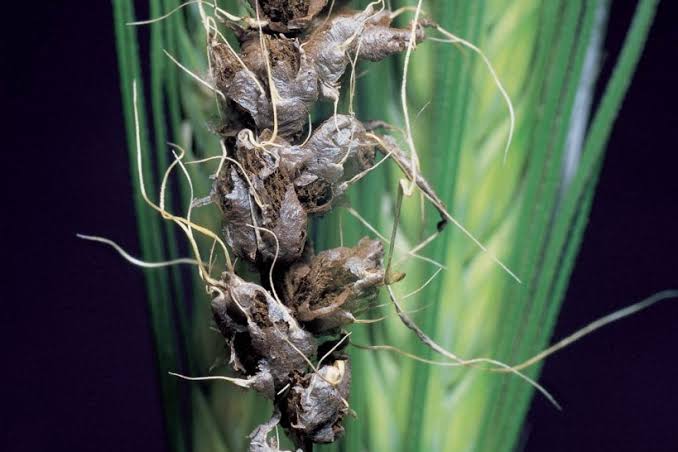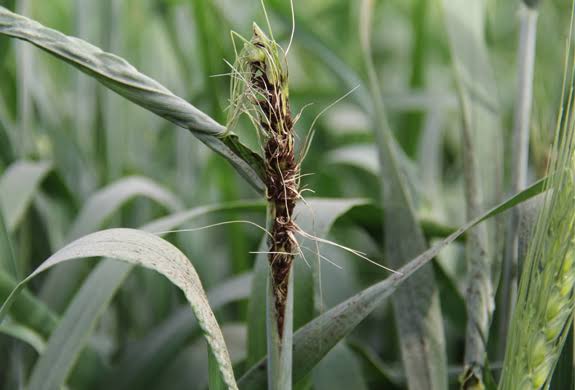Smut, scientifically known as Ustilaginomycetes, refers to a group of fungi that can cause plant diseases. These microscopic organisms often target various crops, affecting their growth and yield. Understanding smut and its impact on agriculture is crucial for farmers and researchers alike.
These fungi, part of the Ustilaginomycotina subphylum, have a peculiar lifestyle as they infect plants, especially cereals like corn and grains. Once a plant falls victim to smut, it experiences abnormal growth, leading to the formation of dark, soot-like masses called sori, which are essentially clusters of spores.
The life cycle of smut fungi involves a complex interaction between the pathogen and its host plant. The spores, known as teliospores, serve as the primary means of dispersal. When these teliospores land on a susceptible plant, they initiate the infection process, penetrating the host tissues. This penetration triggers a series of events that ultimately result in the formation of sori, releasing countless spores into the environment.
The impact of smut on agriculture is substantial, causing economic losses for farmers. Infected plants may suffer reduced yield, poor quality of crops, and in some cases, complete crop failure. The control of smut often involves the use of fungicides, crop rotation strategies, and resistant plant varieties. Researchers continuously strive to develop effective measures to mitigate the impact of smut on crops and ensure food security.
Smut, scientifically identified as Ustilaginomycetes, is a group of fungi with a noteworthy ability to compromise the health and productivity of various plants, especially important crops. Understanding the life cycle and methods of control is crucial for safeguarding agricultural interests and ensuring sustainable food production.
Read Also: Leaf Miners: Description, Damages Caused, Control and Preventive Measures
Plants Affected by Smut (Ustilaginomycetes)

Smut fungi can affect a wide variety of plants, causing diseases that impact their growth and development. Some of the commonly affected plants include:
1. Corn (Maize): Smut can be particularly problematic for corn crops, leading to the formation of large, dark masses on the ears or tassels. This can result in reduced yield and poor-quality corn.
2. Grains (Wheat, Barley, Oats, and Rye): Various cereal crops are susceptible to smut infections, affecting the overall health of the plants and diminishing grain quality. This poses challenges for farmers relying on these grains for food and livestock feed.
3. Sorghum: Smut can also target sorghum plants, causing similar symptoms of abnormal growth and the formation of dark spore masses. This can result in economic losses for sorghum growers.
4. Sugarcane: Smut fungi have been known to infect sugarcane, affecting the stalks and potentially reducing sugar production. Controlling smut in sugarcane is crucial for maintaining the economic viability of sugar production.
5. Various Grasses: Smut fungi are not limited to crops but can also infect various grass species, both in agricultural and natural settings. This includes grasses in pastures and natural grasslands.
Understanding the specific plants affected by smut is essential for implementing targeted prevention and control measures. Farmers and researchers continually work to develop strategies such as resistant plant varieties and effective fungicides to manage smut diseases and minimize their impact on crops.
Damages Caused by Smut

Smut fungi inflict various damages on affected plants, leading to economic losses for farmers and potential disruptions in food and feed production. The damages caused by smut include:
1. Reduced Yield: One of the primary consequences of smut infections is a decline in crop yield. The abnormal growth and formation of spore masses interfere with the normal development of plant tissues, resulting in smaller harvests for crops like corn, wheat, barley, oats, and sorghum.
2. Poor Quality Crops: Smut-infected plants often produce crops of inferior quality. The presence of dark spore masses and the impact on plant tissues can affect the taste, texture, and nutritional value of the harvested grains or other plant products.
3. Crop Failure: In severe cases, smut infections can lead to complete crop failure. The ability of the fungi to compromise the overall health of the plant, coupled with environmental conditions conducive to smut development, may result in the loss of an entire crop, leaving farmers with no harvest to sell or use.
4. Decreased Livestock Feed Quality: For crops used as feed for livestock, such as corn and certain grains, smut-infested crops can provide lower-quality feed. This can have cascading effects on animal health and productivity in the agricultural ecosystem.
5. Economic Impact: The economic impact of smut is significant, affecting both large-scale and small-scale farmers. Reduced yields and poor-quality crops can lead to financial strain, as farmers may face challenges in selling their produce at competitive prices or meeting contractual obligations.
6. Increased Production Costs: Farmers often incur additional costs in their efforts to control and manage smut. This may involve investing in fungicides, implementing crop rotation strategies, or adopting resistant plant varieties. These added expenses contribute to the economic burden caused by smut infections.
Understanding the damages caused by smut is crucial for developing effective management strategies and mitigating the economic impact on agriculture. Ongoing research aims to identify resilient crop varieties and sustainable practices to reduce the prevalence of smut and its associated damages.
Read Also: Weevils Insect: Description, Damages Caused, Control and Preventive Measures
Control and Preventive Measures

Controlling and preventing smut infections involve a combination of cultural, biological, and chemical measures. Here are some strategies employed by farmers and researchers to manage smut:
1. Resistant Plant Varieties: Plant breeding programs focus on developing crop varieties with natural resistance to smut fungi. By incorporating genetic resistance into the plants, farmers can reduce the likelihood and severity of smut infections.
2. Crop Rotation: Rotating crops is an effective cultural practice to disrupt the smut fungi’s life cycle. Changing the planting location helps break the cycle of infection, as smut spores often overwinter in the soil.
3. Sanitation Practices: Removing and destroying infected plant materials, including crop residues and debris, can help reduce the source of smut spores. This practice is essential for preventing the carryover of smut from one growing season to the next.
4. Fungicides: Chemical control measures involve the use of fungicides to manage smut infections. Application timings are critical, and farmers must follow recommended guidelines to ensure effective control while minimizing environmental impact.
5. Seed Treatment: Treating seeds with fungicides before planting is a preventive measure to protect emerging seedlings from smut infections. This method provides an early defense against the establishment of the fungi.
6. Biological Control: Some beneficial microorganisms can antagonize smut fungi. Introducing these biological control agents, such as certain bacteria or fungi, into the soil can help suppress smut populations.
7. Timely Planting: Planting crops at the recommended time can reduce the vulnerability of seedlings to smut infections. Ensuring optimal growing conditions for the plants can enhance their ability to resist and recover from potential smut attacks.
8. Monitoring and Early Detection: Regular field monitoring allows farmers to detect smut infections at an early stage. Early identification enables prompt action, such as targeted fungicide applications or the removal of infected plants, to prevent further spread.
9. Integrated Pest Management (IPM): Adopting an integrated approach that combines multiple control methods is often the most effective strategy. IPM incorporates cultural practices, biological controls, and judicious use of chemical measures for a comprehensive and sustainable approach to smut management.
Implementing a combination of these control and preventive measures is essential for managing smut effectively and maintaining the health and productivity of crops. Ongoing research continues to explore innovative and environmentally friendly approaches to enhance smut control strategies.
Frequently Asked Questions (FAQs) About Smut (Ustilaginomycetes)
1. Q: What is smut?
A: Smut refers to a group of fungi, scientifically known as Ustilaginomycetes, that can cause diseases in various plants, affecting their growth and productivity.
2. Q: Which plants are commonly affected by smut?
A: Smut fungi can infect a range of plants, including corn, grains (wheat, barley, oats, and rye), sorghum, sugarcane, and various grass species.
3. Q: How does smut affect plants?
A: Smut fungi compromise plant health by inducing abnormal growth and forming dark spore masses. This can result in reduced crop yield, poor-quality crops, and in severe cases, complete crop failure.
4. Q: What are the economic impacts of smut infections?
A: Smut infections can lead to economic losses for farmers due to reduced yields, poor-quality crops, and increased production costs. The impact extends to livestock feed quality for crops used in animal nutrition.
5. Q: Are there any resistant plant varieties to smut?
A: Yes, ongoing plant breeding programs focus on developing crop varieties with natural resistance to smut fungi. Using resistant plant varieties is an effective strategy for managing smut.
6. Q: How can smut be controlled and prevented?
A: Control measures include planting resistant varieties, crop rotation, sanitation practices, fungicide application, seed treatment, biological control, timely planting, and integrated pest management (IPM).
7. Q: Can smut be transmitted through seeds?
A: Yes, smut fungi can be transmitted through infected seeds. Seed treatment with fungicides is a preventive measure to protect emerging seedlings from smut infections.
8. Q: What is the role of crop rotation in smut management?
A: Crop rotation disrupts the smut fungi’s life cycle by changing the planting location, helping to break the cycle of infection and reduce the risk of smut in subsequent growing seasons.
9. Q: How can farmers monitor and detect smut early?
A: Regular field monitoring allows farmers to detect smut infections at an early stage. Early identification enables prompt action, such as targeted fungicide applications or the removal of infected plants.
10. Q: Is there ongoing research on smut control strategies?
A: Yes, researchers are actively exploring innovative and environmentally friendly approaches, including biological controls and sustainable practices, to enhance smut control strategies and minimize their impact on crops.

